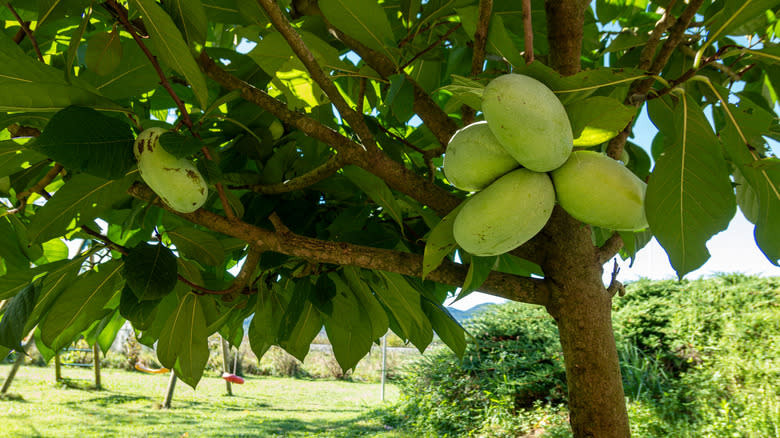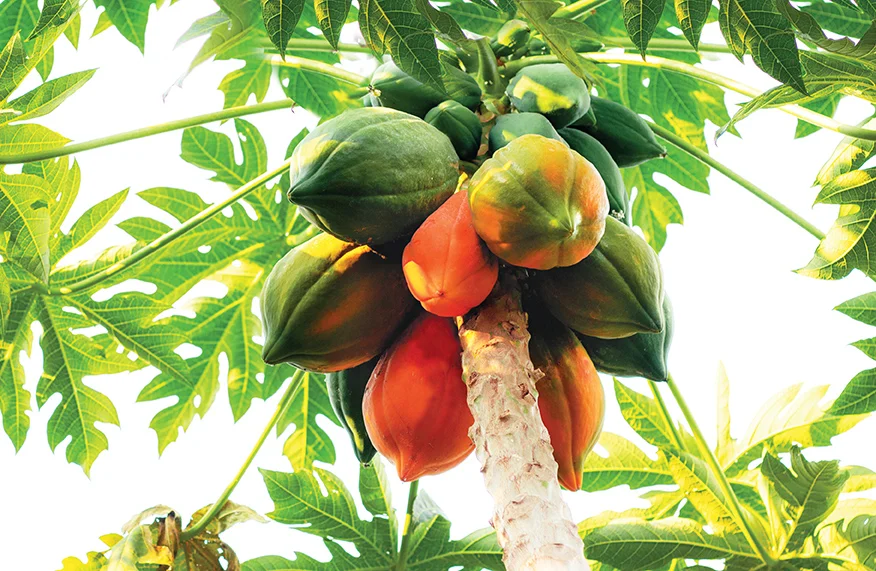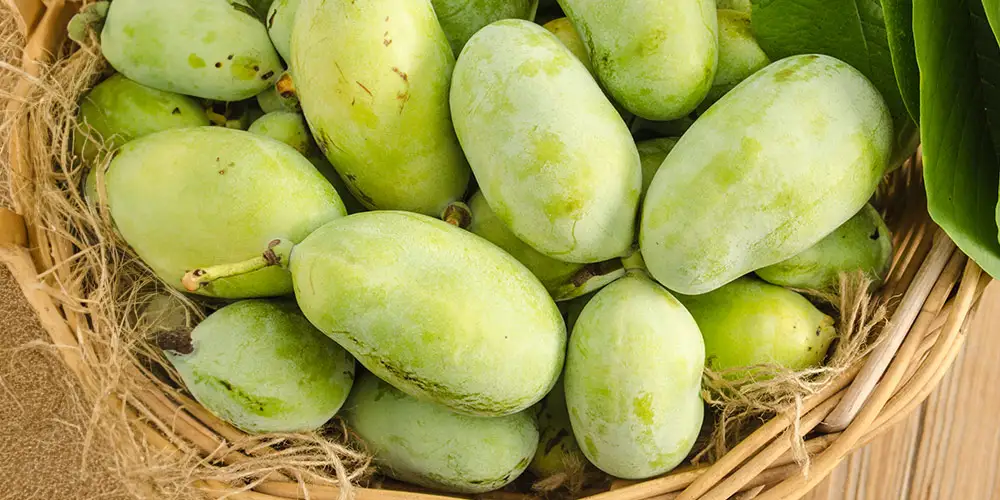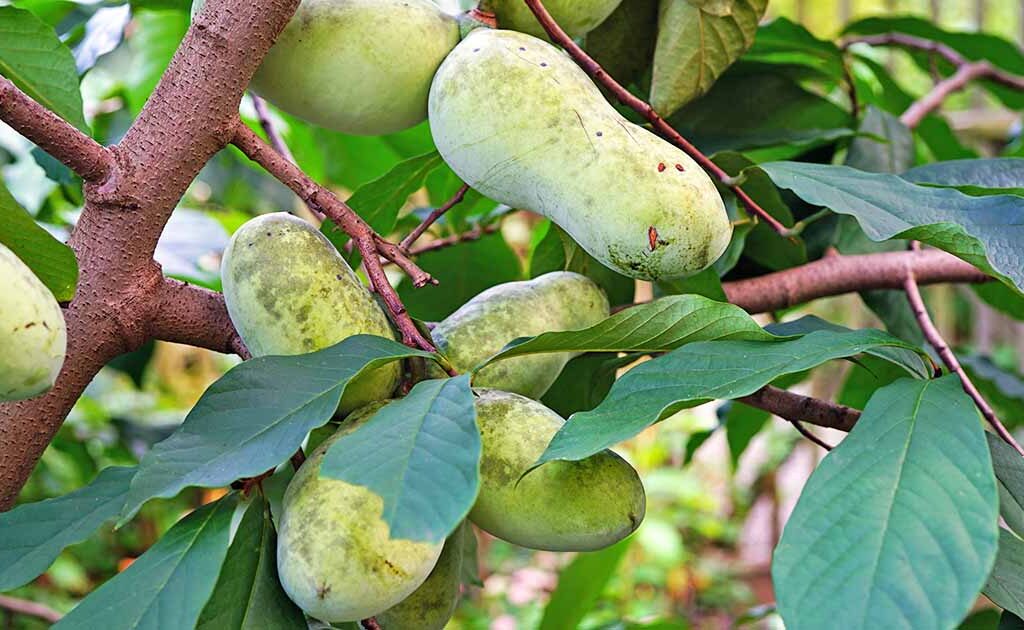Pawpaw trees (Asimina triloba) are one of America’s best-kept horticultural secrets. Native to the eastern United States, these small, deciduous fruit trees produce the largest edible native fruit in North America. Often described as a cross between a banana, mango, and custard apple, pawpaws deliver a unique tropical flavor in a tree hardy enough to survive in temperate climates.
If you’ve ever wanted to grow a rare, delicious, and low-maintenance fruit tree, this guide will show you exactly how to grow pawpaw trees in the USA, from choosing the right variety to planting, caring for, and harvesting your own homegrown pawpaws.

Why Grow Pawpaw Trees?
Pawpaw trees aren’t just a curiosity; they’re valuable for several reasons:
- Native to the USA, making them naturally adapted to local pests and weather
- Low-maintenance and disease-resistant
- Unique, custard-like fruit with a tropical flavor
- Attractive trees with large, tropical-looking leaves
- Perfect for backyard orchards, food forests, or native plant gardens
Plus, pawpaws are rich in vitamins A and C, magnesium, iron, and antioxidants.

Where Do Pawpaw Trees Grow Best?
Pawpaw trees are native to the eastern and midwestern United States, ranging from New York to Florida and as far west as Nebraska and Texas. They thrive in USDA hardiness zones 5–9.
Ideal Conditions:
- Climate: Temperate with cold winters and humid summers
- Soil: Deep, fertile, well-draining soil rich in organic matter
- pH: Slightly acidic to neutral (5.5 to 7.0)
- Sunlight: Partial shade when young, full sun as mature trees
Fun fact: In the wild, pawpaws often grow as understory trees, but in cultivation, they produce better fruit yields in full sun.
Choosing the Right Pawpaw Variety
There are dozens of pawpaw cultivars available, each offering different flavors, fruit sizes, and ripening times. Here are some popular choices for home gardeners:
- ‘Sunflower’ – Large fruit, self-fertile, excellent flavor
- ‘Shenandoah’ – Mild, sweet taste with few seeds
- ‘Susquehanna’ – Big, rich-flavored fruit and heavy producer
- ‘Overleese’ – Creamy texture, very sweet
- ‘KSU-Atwood’ – Early ripening with high yields
Pro tip: While some pawpaws are partially self-fertile, it’s best to plant at least two different cultivars for reliable cross-pollination and heavier fruiting.

How to Plant Pawpaw Trees
When to Plant:
The best time to plant pawpaw trees is in spring or fall when the soil is cool and moist.
Where to Plant:
Choose a spot with:
- Full sun for mature trees (partial shade when young)
- Sheltered from strong winds
- Rich, well-drained soil with good moisture retention
Planting Instructions:
- Dig a hole twice as wide and as deep as the tree’s root ball
- Loosen surrounding soil and mix in organic compost
- Gently remove the tree from its container, keeping the delicate roots intact
- Place the tree in the hole at the same depth it grew in the nursery
- Backfill with soil and firm gently
- Water deeply and apply a 3-inch layer of mulch to conserve moisture and suppress weeds
Important: Pawpaw trees have sensitive taproots, so be careful not to disturb them during planting.
How to Care for Pawpaw Trees
Pawpaw trees are relatively low-maintenance but benefit from some basic care:
Watering:
- Water deeply and regularly, especially during the first 2–3 years
- Aim to keep the soil consistently moist but not soggy
- Mature trees are drought-tolerant but produce better with steady moisture
Mulching:
Apply a 2–3 inch layer of organic mulch (like wood chips or leaf mold) around the base, keeping it a few inches from the trunk. This maintains soil moisture and regulates temperature.
Fertilizing:
- Year 1: No fertilizer needed if planted in fertile soil
- After Year 2: Apply a balanced organic fertilizer (10-10-10) in early spring
- Avoid over-fertilizing, which can cause excessive leafy growth at the expense of fruit production
Pruning:
Minimal pruning is needed. Remove:
- Dead, damaged, or crossing branches in late winter
- Low, weak growth and suckers at the base
Light shaping can improve airflow and light penetration, boosting fruit yields.

Pollination and Fruit Production
Unlike most fruit trees, pawpaws have unusual, insect-pollinated flowers. Natural pollinators include flies, beetles, and carrion insects, which are attracted by the flowers’ earthy scent.
How to Improve Pollination:
- Plant at least two different varieties within 30 feet for cross-pollination
- Hand-pollinate using a small paintbrush, transferring pollen from one flower to another
- Plant companion flowers (like marigolds or dill) nearby to attract pollinating insects
Harvesting Pawpaw Fruit
When to Harvest:
Pawpaws ripen in late summer to early fall (August–October), depending on your region and variety.
Signs of ripeness:
- Fruit turns from green to yellowish or brownish
- Slightly soft to the touch (like a ripe avocado)
- Sweet, fruity aroma
- Easily detaches from the branch
How to Harvest:
Gently twist the fruit from the tree or clip with pruning shears. Handle carefully, as ripe pawpaws bruise easily.

Storing and Enjoying Pawpaws
Fresh pawpaws have a short shelf life:
- Refrigerate immediately and use within 2–3 days for peak flavor
- Flesh can be frozen for smoothies, baked goods, or ice cream
The custard-like pulp tastes like a blend of banana, mango, and melon — perfect for eating fresh, making pudding, jam, or even craft beer.
Common Problems and Pests
While generally trouble-free, pawpaw trees can encounter a few issues:
- Pawpaw Peduncle Borer: Larvae that damage flower stems; prune affected stems
- Deer and Rabbits: May nibble young trees — use tree guards
- Poor Pollination: Plant multiple varieties or hand-pollinate
Most pawpaws are resistant to serious diseases and insect pests.
Growing Pawpaws in Containers
Yes — you can grow pawpaw trees in large containers if you lack garden space!
Container Tips:
- Use a deep 15–20 gallon pot with excellent drainage
- Fill with a rich, well-draining potting mix
- Provide full sun and regular watering
- Protect from frost in colder regions
- Consider dwarf or compact varieties like ‘Sunflower’
Final Thoughts
If you’re looking for a unique, native fruit tree that’s both delicious and ornamental, pawpaw trees are a fantastic choice. With a little patience — trees begin fruiting in 4–7 years — you’ll be rewarded with generous harvests of luscious, tropical-flavored fruit right in your backyard.
By choosing the right variety, providing well-drained soil, ensuring good pollination, and following basic care guidelines, you can successfully grow pawpaw trees anywhere in USDA zones 5–9.






Leave A Comment